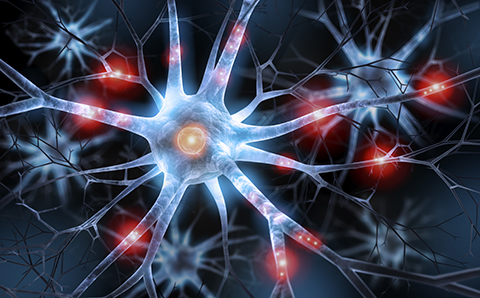From the journals: JBC
New stroke drug doesn’t impair memory. DNA damage and repair in the 3D genome. A new platform for detecting microRNAs. Read about papers on these topics recently published in the Journal of Biological Chemistry.
New stroke drug doesn’t impair memory

Learning and memory require synaptic plasticity; neural connections must be able to form and re-form to establish patterns of signal transduction. Scientists have long known that the Ca2+/calmodulin-dependent protein kinase II, or CaMKII, plays an important role in forming memories. The neuroprotective peptide drug tatCN19o, an inhibitor of CaMKII, is a promising treatment for cerebral ischemia, or stroke. Studies have shown that sustained genetic inhibition of CaMKII can impair memory; however, researchers were not yet sure whether short-term CaMKII inhibition with tatCN19o could also have this negative effect.
Nicole Rumian, Nicole Brown and colleagues at the University of Colorado Anschutz Medical Campus have now described in an article in the Journal of Biological Chemistry their findings that acute CaMKII inhibition using the neuroprotective peptide tatCN19o did not affect pre-formed memories and only mildly and transiently interfered with learning. The authors used a concentration of tatCN19o 500 times that required for neuroprotection and found that mice injected with the drug displayed no impairment in fear-conditioning memory tests. Furthermore, they showed that in rat cortical cell cultures and live pigs this drug retained its neuroprotective functions at very low doses, even when administered 30 to 60 minutes after ischemia.
These findings support tatCN19o as a promising candidate to treat stroke and show that two of the biggest fears of its short-term use, that it could induce retrograde amnesia or have a long-term impact on learning, were not detected and thus do not pose a counter-indication.
DNA damage and repair in the 3D genome
Ultraviolet ray–induced DNA damage is a significant risk factor for skin cancer and other diseases. Studies have previously shown that DNA mutations caused by UV damage are repaired more efficiently in an open chromatin state, where repair enzymes can more easily access the DNA strands. However, researchers do not yet know whether UV-induced DNA damage or subsequent repair is affected by the 3D organization of the genome itself within the nucleus.
In their recent paper published in the Journal of Biological Chemistry, Ümit Akköse and Ogün Adebali at Sabanci University in Turkey describe how they investigated the synergistic effects of UV damage and 3D genome organization. They integrated chromosome conformation capture sequencing, excision repair sequencing, Damage-seq and in silico simulations, and confirmed that the peripheral genomic elements shield the central genomic DNA from UV-induced damage, particularly the formation of pyrimidine-pyrimidone [6-4] photoproducts. Furthermore, they found no difference in repair efficiency between DNA at the core and the periphery of the nucleus after 12 minutes of irradiation compared with two hours of irradiation, suggesting that the 3D organization of the genome is altered by UV exposure in this window.
This study provides insights into the complex interplay between 3D genome organization and environmental sources of DNA damage such as UV rays. Further research in this area could lead to the development of new strategies for preventing DNA damage and subsequent genomic instability.
A new platform for detecting microRNAs
The small noncoding RNAs known as microRNAs, or miRNAs, can regulate gene expression or, in the case of numerous diseases such as cancers, dysregulate it. Traditional methods of detecting miRNAs include Northern blotting, DNA microarrays and real-time polymerase chain reaction, or RT-PCR, which can be slow and difficult to validate and require a large amount of starting material. More recent isothermal amplification techniques such as rolling circle, strand displacement and loop-mediated isothermal amplification have other issues such as limited sensitivity, complicated design and numerous false positives.
In a recent paper in the Journal of Biological Chemistry, Xiuen Cao and colleagues at Central South University in Hunan, China, describe how they developed a new application to detect miRNAs using a platform that combines nonlinear branched hybridization chain reaction, or bHCR, which uses single-stranded DNA as an initiator to trigger assembly of a network of branched DNA hairpin structures, and DNAzymes, which are synthetic DNA sequences with catalytic function, to detect miRNAs. This method used DNAzymes that cleave the bow structures in bHCR to generate new branch-generating trigger sequences, thus exponentially speeding up amplification. The researchers showed that they were able to detect miR-21, a miRNA commonly expressed in cancer, in human liver samples in an assay that was simple, efficient, low cost and, importantly, protein enzyme-free.
This novel method for detecting miR-21 could be adapted to detect other miRNAs with the same accuracy as RT-PCR but with greater reproducibility. With further validation and testing, the bHCR-DNAzyme detection method could have potential for cancer diagnosis in the clinic.
Enjoy reading ASBMB Today?
Become a member to receive the print edition four times a year and the digital edition monthly.
Learn moreGet the latest from ASBMB Today
Enter your email address, and we’ll send you a weekly email with recent articles, interviews and more.
Latest in Science
Science highlights or most popular articles

Mining microbes for rare earth solutions
Joseph Cotruvo, Jr., will receive the ASBMB Mildred Cohn Young Investigator Award at the ASBMB Annual Meeting, March 7–10, just outside of Washington, D.C.

Fueling healthier aging, connecting metabolism stress and time
Biochemist Melanie McReynolds investigates how metabolism and stress shape the aging process. Her research on NAD+, a molecule central to cellular energy, reveals how maintaining its balance could promote healthier, longer lives.

Mapping proteins, one side chain at a time
Roland Dunbrack Jr. will receive the ASBMB DeLano Award for Computational Biosciences at the ASBMB Annual Meeting, March 7–10, just outside of Washington, D.C.

Exploring the link between lipids and longevity
Meng Wang will present her work on metabolism and aging at the ASBMB Annual Meeting, March 7-10, just outside of Washington, D.C.

Defining a ‘crucial gatekeeper’ of lipid metabolism
George Carman receives the Herbert Tabor Research Award at the ASBMB Annual Meeting, March 7–10, just outside of Washington, D.C.

The science of staying strong
Muscles power every movement, but they also tell the story of aging itself. Scientists are uncovering how strength fades, why some species resist it and what lifestyle and molecular clues could help preserve muscle health for life.

